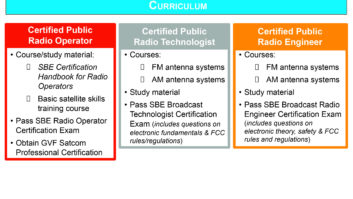NPR Satellite Services has launched The Hub @NPRSS, a content distribution service that allows networks to send programming to stations without the need or expense of operating a local head-end. KOSU, a member-supported public radio network serving Oklahoma, has signed on as its first customer.

Broadcasters send their audio to the Network Operations Center located at National Public Radio’s headquarters in Washington. The Hub @ NPRSS clients are issued a website that they manage, and with it, they can determine where and when their content plays, either through satellite uplinks or terrestrial IP streaming.
Director of NPRSS Darlene Holmes explains that The Hub @NPRSS provides an “efficient way to deliver content without the upfront uplinking costs to build and maintain at their facility. Particularly for stations, it provides new revenue opportunities via spot insertions and localized IDs, plus it cuts costs.”
“This is a system that is directly designed with group operators and operational budgets in mind,” says NPRSS Operations Architect Matt Walther, who handles day-to-day engineering and operations of the satellite services.
“If an operator has a show that they would like to air on some, but not all, of their stations, they can feed that show to us through either a dedicated secondary stream or as a file delivery. That show can then be scheduled on a receiver by receiver basis. If they choose to use file delivery, the file can be scheduled and played directly from the receiver itself or if needed, saved to their own playout system,” said Walther. “Taking this to the next level, if that operator wants to resell their own programming, they can now do that. Suppose this operator runs a talk format with a popular garden or sports talk show. The Hub allows them control over their own content.”
Holmes adds, “With stations losing engineers and funding being cut, The Hub is a great alternative to keep stations thriving and growing revenues.”
The Hub @ NPRSS was created by NPR Satellite Services in partnership with San Diego, Calif.-based international telecommunications equipment maker XDS Pico Digital.

“About a year ago, we started looking at systems to be able to help clients who have older head-ends that are reaching the end of life. This system had to be proven, reliable and flexible enough that we could scale to any potential client who wanted to come onboard,” says Walther. “During this process we reviewed IP codecs and satellite head-ends from several vendors and settled on the GatesAir IP codecs and Pico Digital’s X-Digital XDS headend.
“Once we got the equipment, we spent quite a bit of time verifying, torture-testing really, every component and aspect,” Walther says. “We have redundant modulators, XDS chassis and servers — even IP networks into our building. We also kept a focus on what the customer experience would be like regarding how clients manage their own network programs and receivers. This led to some system design changes for better workflows. Both GatesAir and Pico have been great to work with and were quick to respond in helping us achieve these goals.”
Holmes says the origin of the service’s name came because it is “the place where the heartbeat of radio flows from and comes together.”
“One important item to remember is that content management goes beyond station scheduling. For example we are setting up active back-up systems that can feed content from a secondary location when something happens to the primary,” says Walther. “KOSU is an example of this. They have two sites set up and are actively connected to the Hub. If there is a problem with one site, they can disconnect those streams and have their secondary site streaming content within seconds.”
Holmes concludes: “Stations need to think about the longevity of their equipment, resources and ongoing support in the future.”
Inside The Hub @NPRSS
Here is a list of the equipment powering The Hub @NPRSS
Rack 5W 07 Top to Bottom
● Clocks (red/green — not currently hooked up)
Fostex monitor feed off of the Axia Audio XY router node (directly below) to monitor all Hub feeds
● KVM monitor
● Another Axia Audio button selector
● VU monitoring
● Engineering utility server
● Hub Application Primary
● Hub Streaming Primary
● Hub Web Primary
● Hub Database Primary
● Hub Application Secondary
● Hub Streaming Secondary
● Hub Web Secondary
● Hub Database Secondary
Rack 5W 08
● Quintech RF splitter to feed Ku and C Bands to receivers
● Axia Audio Analog node (outputs from receivers)
● Axia Audio GPIO node (outputs from receivers)
● XDS Pro-4Q receiver for Ku Band
● Axia Audio Analog node (outputs from receivers)
● Axia Audio GPIO node (outputs from receivers)
● XDS Pro-1Q receiver for C Band
● Axia Audio Analog node (outputs from receivers)
● Axia Audio GPIO node (outputs from receivers)
● Axia Audio Analog node (outputs from receivers)
● Axia Audio GPIO node (outputs from receivers)
Rack 5W 09
● Axia Audio Analog node (outputs from IP codecs)
● Axia Audio GPIO node (outputs from IP codecs)
● Axia Audio Analog node (outputs from IP codecs)
● Axia Audio GPIO node (outputs from IP codecs)
● GatesAir Intraplex IP Link 100 (5x = 4 active with 1 spare)
Rack 5W 10
● Quintech active splitter
● Axia Audio Analog node
● Axia Audio GPIO node
● Axia Audio Analog node
● Axia Audio GPIO node
● NewTec Modulation Primary (Ku Band)
● NewTec Modulation Switch
● NewTec Modulation Secondary
● NewTec Modulation Primary (C Band)
● NewTec Modulation Switch
● NewTec Modulation Secondary
● XDS Pro-1Q receiver for Ku Band
● XDS Pro-1Q receiver for C Band
● XDS X-Digital System Chassis Primary
● XDS X-Digital System Chassis Secondary












